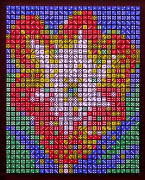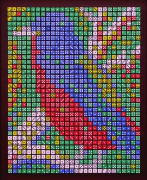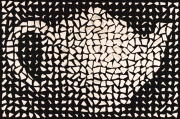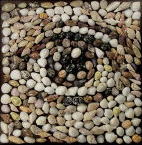| |
 Many of us experiment with computers to create and/or process images,
and we are often bold enough to call the results computer art, or even
'Art.' In truth, mixtures of brash novelty and serious message are dicey,
perhaps impossible. New tools, for new means of expression, lead to
new results: provocative, crude, delicate, personal, grand, arrogant,
humble, megalomaniacal, predictive, retrospective, sensitive, tasteless.
In a way, disarray in the arts mirrors our troubled world and its new
methods of building and destroying. What happens to the world, of course,
is a much more serious matter than what happens to the arts. But the
narrower and wider views exhibit this curious similarity: disproportionate
attention to tangential issues.
Many of us experiment with computers to create and/or process images,
and we are often bold enough to call the results computer art, or even
'Art.' In truth, mixtures of brash novelty and serious message are dicey,
perhaps impossible. New tools, for new means of expression, lead to
new results: provocative, crude, delicate, personal, grand, arrogant,
humble, megalomaniacal, predictive, retrospective, sensitive, tasteless.
In a way, disarray in the arts mirrors our troubled world and its new
methods of building and destroying. What happens to the world, of course,
is a much more serious matter than what happens to the arts. But the
narrower and wider views exhibit this curious similarity: disproportionate
attention to tangential issues.
On
the world scene, the desperate and tragic fact of the matter is that
we are destroying the biosphere. This monstrous problem fragments into
a well-known litany: global warming, trashing of resources, toxic pollution,
extinction of species and of human societies and their multifarious
world views — all of these trends relentlessly compounded by more and
more people. Future generations face an impoverishment, of habitat and
culture, disheartening beyond description. And where does our attention
go, as fresh water wanes and the deserts grow? Individually, to mind-numbing
entertainment; collectively to savaging societies that are trying to
undo us.
 Art,
of a hundred varieties, can be that many more ways of describing the
things that delighted us, and people and things that we cared about.
And of recording an overwhelming sense of loss. Images, and some of
their meanings,may remain decipherable longer than words. Including
mosaic images, of course — what better metaphor for civilizations frozen,
fractured and abandoned? Let us make every possible sort of archive,
for uncertain and remote archeologists, of what people were motivated
by, and what they valued, and why the former destroyed the latter. Art,
of a hundred varieties, can be that many more ways of describing the
things that delighted us, and people and things that we cared about.
And of recording an overwhelming sense of loss. Images, and some of
their meanings,may remain decipherable longer than words. Including
mosaic images, of course — what better metaphor for civilizations frozen,
fractured and abandoned? Let us make every possible sort of archive,
for uncertain and remote archeologists, of what people were motivated
by, and what they valued, and why the former destroyed the latter.
 Art,
yes, for the sake of a record: living, breathing, thinking, feeling,
hopeful, aggrieved humans were here. Images in robust material, for
durability and low-tech reception, buried in vaults and landfills. Quixotic
in the bitter extreme, hope turned tragic and inward, a million personal
views, contrasting what might have been with what did happen, as could-have-been
citizens vegetated or starved, while corporations and armed forces sallied
forth to make the world, for a while, safe and bountiful for scavengers. Art,
yes, for the sake of a record: living, breathing, thinking, feeling,
hopeful, aggrieved humans were here. Images in robust material, for
durability and low-tech reception, buried in vaults and landfills. Quixotic
in the bitter extreme, hope turned tragic and inward, a million personal
views, contrasting what might have been with what did happen, as could-have-been
citizens vegetated or starved, while corporations and armed forces sallied
forth to make the world, for a while, safe and bountiful for scavengers.
|
|
 Many of us experiment with computers to create and/or process images,
and we are often bold enough to call the results computer art, or even
'Art.' In truth, mixtures of brash novelty and serious message are dicey,
perhaps impossible. New tools, for new means of expression, lead to
new results: provocative, crude, delicate, personal, grand, arrogant,
humble, megalomaniacal, predictive, retrospective, sensitive, tasteless.
In a way, disarray in the arts mirrors our troubled world and its new
methods of building and destroying. What happens to the world, of course,
is a much more serious matter than what happens to the arts. But the
narrower and wider views exhibit this curious similarity: disproportionate
attention to tangential issues.
Many of us experiment with computers to create and/or process images,
and we are often bold enough to call the results computer art, or even
'Art.' In truth, mixtures of brash novelty and serious message are dicey,
perhaps impossible. New tools, for new means of expression, lead to
new results: provocative, crude, delicate, personal, grand, arrogant,
humble, megalomaniacal, predictive, retrospective, sensitive, tasteless.
In a way, disarray in the arts mirrors our troubled world and its new
methods of building and destroying. What happens to the world, of course,
is a much more serious matter than what happens to the arts. But the
narrower and wider views exhibit this curious similarity: disproportionate
attention to tangential issues.
 Art,
of a hundred varieties, can be that many more ways of describing the
things that delighted us, and people and things that we cared about.
And of recording an overwhelming sense of loss. Images, and some of
their meanings,may remain decipherable longer than words. Including
mosaic images, of course — what better metaphor for civilizations frozen,
fractured and abandoned? Let us make every possible sort of archive,
for uncertain and remote archeologists, of what people were motivated
by, and what they valued, and why the former destroyed the latter.
Art,
of a hundred varieties, can be that many more ways of describing the
things that delighted us, and people and things that we cared about.
And of recording an overwhelming sense of loss. Images, and some of
their meanings,may remain decipherable longer than words. Including
mosaic images, of course — what better metaphor for civilizations frozen,
fractured and abandoned? Let us make every possible sort of archive,
for uncertain and remote archeologists, of what people were motivated
by, and what they valued, and why the former destroyed the latter.  Art,
yes, for the sake of a record: living, breathing, thinking, feeling,
hopeful, aggrieved humans were here. Images in robust material, for
durability and low-tech reception, buried in vaults and landfills. Quixotic
in the bitter extreme, hope turned tragic and inward, a million personal
views, contrasting what might have been with what did happen, as could-have-been
citizens vegetated or starved, while corporations and armed forces sallied
forth to make the world, for a while, safe and bountiful for scavengers.
Art,
yes, for the sake of a record: living, breathing, thinking, feeling,
hopeful, aggrieved humans were here. Images in robust material, for
durability and low-tech reception, buried in vaults and landfills. Quixotic
in the bitter extreme, hope turned tragic and inward, a million personal
views, contrasting what might have been with what did happen, as could-have-been
citizens vegetated or starved, while corporations and armed forces sallied
forth to make the world, for a while, safe and bountiful for scavengers.